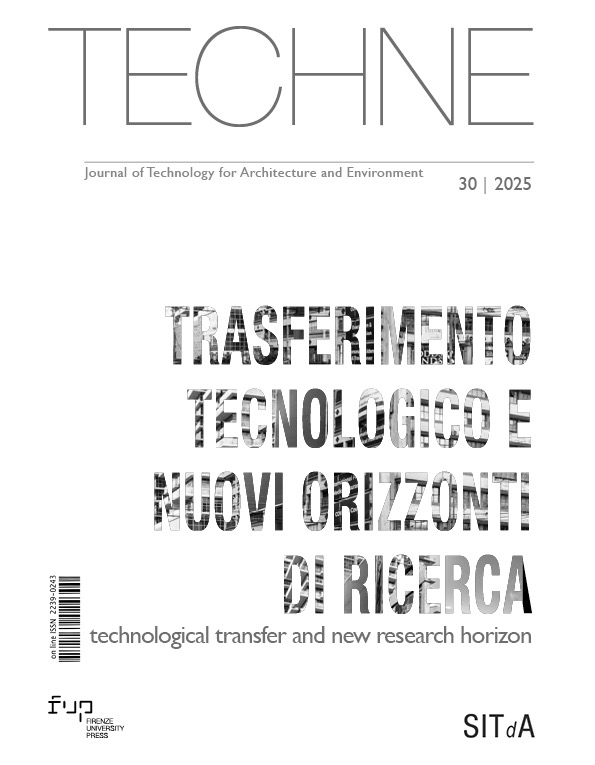Published 2025-11-07
Keywords
- climate adaptation,
- climate neutrality,
- building–outdoor space system,
- environmental indicators,
- environmental design
How to Cite
Copyright (c) 2025 Federica Dell'Acqua, Sara Verde, Federica Paragliola

This work is licensed under a Creative Commons Attribution 4.0 International License.
Abstract
The transition of cities towards climate-resilient urban arrangements requires the development of operational tools to support and strengthen the capacity of public administrations to implement climate adaptation measures at the local scale, within the broader urban context as outlined by national technical policy guidelines. In cities, the system of neighborhood facilities, when designed according to climate-oriented principles, represents a potentially effective network for enhancing climate adaptation for the climate vulnerability reduction. The paper, developed within the framework of the PRIN 2022 PNRR “REACT” research project, presents the preliminary results of the UNINA Research Unit, aimed at developing a method for analyzing the characteristics of the building-open space system that influence climate vulnerability, as well as to provide targeted guidelines for climate adaptation interventions on public facilities, considering their potential for replication in similar urban contexts.
Downloads
References
- Apreda, C., D’Ambrosio, V. and Di Martino, F. (2019), “A climate vulnerability and impact assessment model for complex urban systems”, Environmental Science & Policy, Vol. 93, pp. 11-26. Available at: https://doi.org/10.1016/j.envsci.2018.12.016 (accessed 12 February 2025). DOI: https://doi.org/10.1016/j.envsci.2018.12.016
- British Columbia (2021), Climate Preparedness and Adaptation Strategy. Draft Strategy and Phase 1 Actions for 2021-2022. Available at: https://www2.gov.bc.ca/assets/gov/environment/climate-change/adaptation/cpas_2021.pdf (accessed 01 June 2025).
- CMCC – Centro Euro-Mediterraneo sui Cambiamenti Climatici (n.d.), Scenari climatici per l’Italia. Available at: cmcc.it/it/scenari-climatici-per-litalia#rcp (accessed 12 February 2025).
- COM (2021), Forging a climate-resilient Europe – the new EU Strategy on Adaptation to Climate Change, 82 final.
- Comune di Napoli (2024), Verso il nuovo Piano Urbanistico della Città di Napoli – Per una Città Giusta, Sostenibile e Attrattiva. Available at: comune.napoli.it/versoilpuc (accessed 12 February 2025).
- Echevarría Icaza, L., Van den Dobbelsteen, A. And Van der Hoeven, F. (2016). Integrating Urban Heat Assessment in Urban Plans. Sustainability, Vol. 8, n. 4, p. 320. Available at: https://doi.org/10.3390/su8040320. DOI: https://doi.org/10.3390/su8040320
- EEA – European Environmental Agency (2020), Urban adaptation in Europe – How cities and towns respond to climate change. Available at: eea.europa.eu/publications/urban-adaptation-in-europe (accessed 12 February 2025).
- EEA – European Environmental Agency (2024), European Climate Risk Assessment – EEA Report 01/2024. Available at: https://www.eea.europa.eu/en/analysis/publications/european-climate-risk-assessment (accessed 01 June 2025).
- Forster, P.M., Smith, C. et al. (2025), “Indicators of Global Climate Change 2024: annual update of key indicators of the state of the climate system and human influence”, Earth System Science Data, Vol.17, pp. 2641-2680. Available at: https://doi.org/10.5194/essd-17-2641-2025 (accessed 01 June 2025). DOI: https://doi.org/10.5194/essd-17-2641-2025
- Frondizi, R. (2020), La Terza Missione delle Università. Strategia, Valutazione e Performance, Giappichelli Editore, Torino.
- Losasso, M., Giugni, M., D’Ambrosio, V. et al. (2021), “1. Progettazione multiscalare per la resilienza dei Distretti urbani. Eco-distretti e soluzioni climate-proof per l’area occidentale di Napoli. Il caso applicativo di Soccavo/Multi-scale Design for the Resilience of Urban Districts. Eco-districts and Climate-proof Solutions for the Western Area of Naples. The Application Case of Soccavo”, in Bologna, R., Losasso, M., Mussinelli, E. and Tucci, F. (Eds), Dai distretti urbani agli eco-distretti. Metodologie di conoscenza, programmi strategici, progetti pilota per l’adattamento climatico/ From Urban Districts to Eco-districts. Knowledge Methodologies, Strategic Programmes, Pilot Projects for Climate Adaptation, Maggioli, Santarcangelo di Romagna, pp. 78-121.
- MASE – Ministero dell’Ambiente e della Sicurezza Energetica (2022), PTE – Piano Nazionale di Transizione Ecologica. Available at: https://www.mase.gov.it/sites/default/files/archivio/allegati/PTE/PTE-definitivo.pdf (accessed 05 March 2025).
- MASE – Ministero dell’Ambiente e della Sicurezza Energetica (2023a), Piano Nazionale di Adattamento ai Cambiamenti Climatici. Available at: https://mase.gov.it/pagina/piano-nazionale-di-adattamento-ai-cambiamenti-climatici-pnacc (accessed 05 March 2025). DOI: https://doi.org/10.63111/QES-2025.1.0009
- MASE – Ministero dell’Ambiente e della Sicurezza Energetica (2023b), PNIEC – Piano Nazionale Integrato per l’Energia e il Clima. Available at: https://www.mase.gov.it/sites/default/files/PNIEC_2023.pdf (accessed 05 March 2025).
- Nardino, M., Cremonini, L., Crisci, A., Georgiadis, T., Guerri, G., Morabito, M., and Fiorillo, E. (2022). Mapping daytime thermal patterns of Bologna municipality (Italy) during a heatwave: A new methodology for cities adaptation to global climate change. Urban Climate, Vol. 46, p. 101317. DOI: https://doi.org/10.1016/j.uclim.2022.101317
- Nonaka, I. (1994), “A dynamic theory of organizational knowledge creation”, Organization Science, vol. 5, pp. 14-37. Available at: https://doi.org/10.1093/fampra/cmw098 (accessed 05 March 2025). DOI: https://doi.org/10.1287/orsc.5.1.14
- Salvati, A. and Kolokotroni, M. (2020), Impact of urban albedo on microclimate and thermal comfort over a heat wave event in London. Available at: https://bura.brunel.ac.uk/handle/2438/22214.
- UNEP – United Nations Environment Programme (2024), Come hell and high water. As fires and floods hit the poor hardest, it is time for the world to step up adaptation actions. Adaptation Gap Report 2024. Available at: https://www.unep.org/resources/adaptation-gap-report-2024 (accessed 05 March 2025).
- Van der Hoeven, F. and Wandl, A. (2014), “Amsterwarm: Mapping the landuse, health and energy-efficiency implications of the Amsterdam urban heat island”, Building Services Engineering Research and Technology, Vol. 36, n. 1, pp. 67-88. Available at: https://doi.org/10.1177/0143624414541451. DOI: https://doi.org/10.1177/0143624414541451






